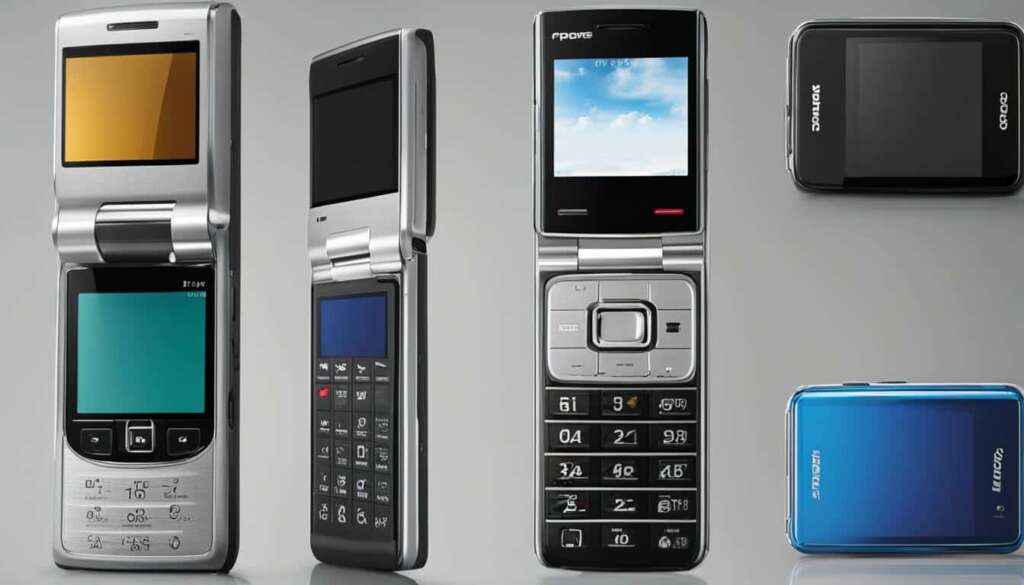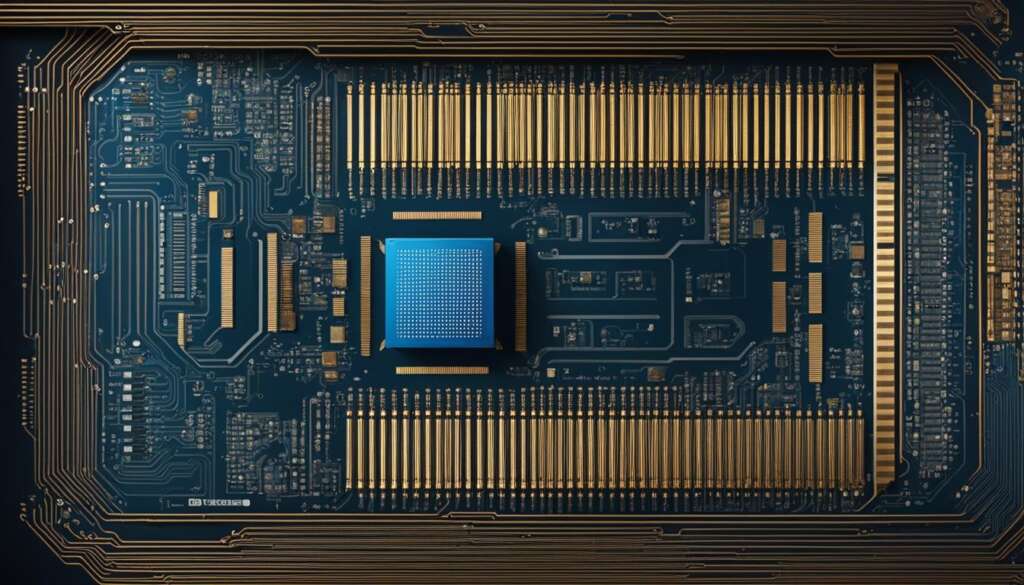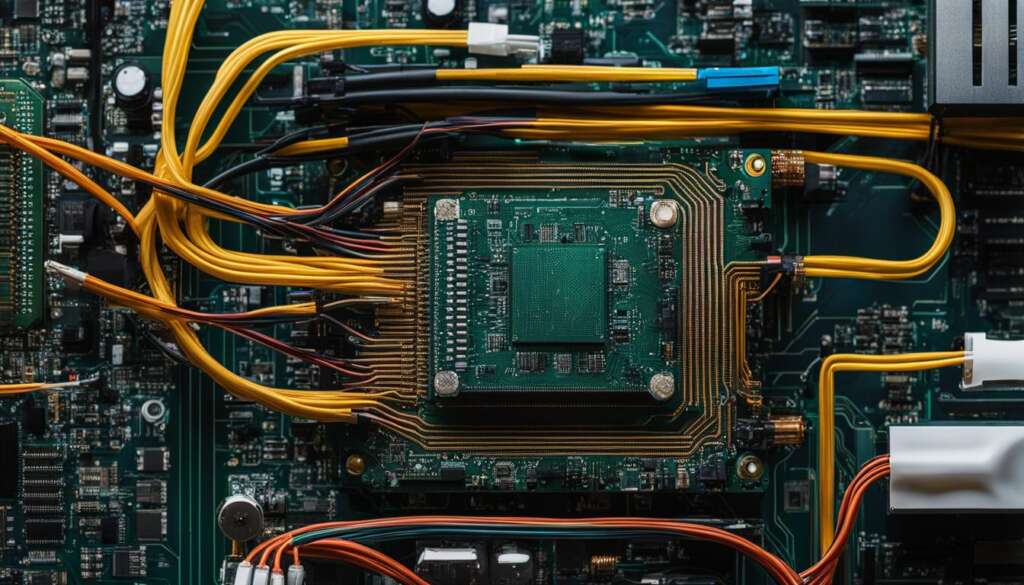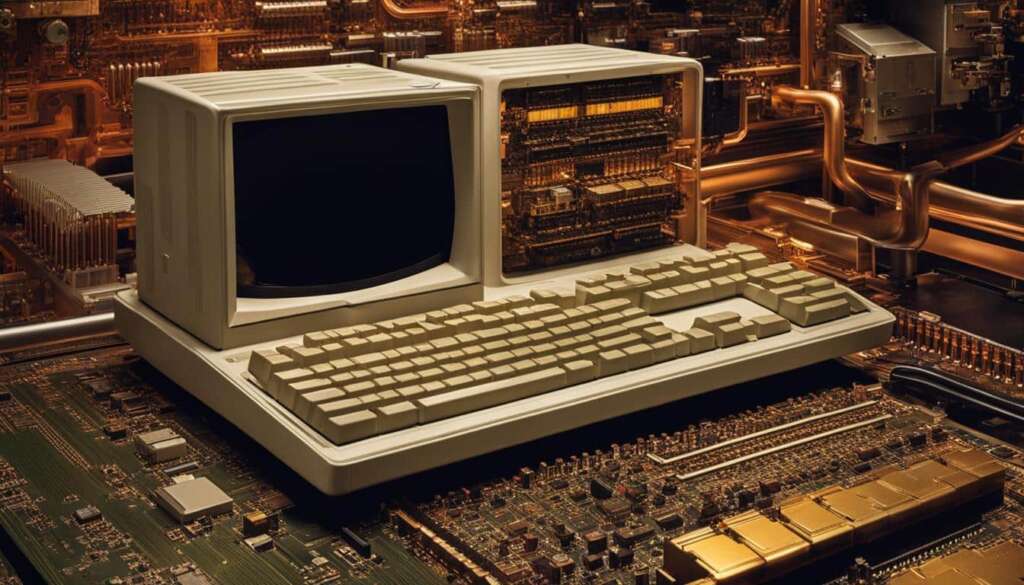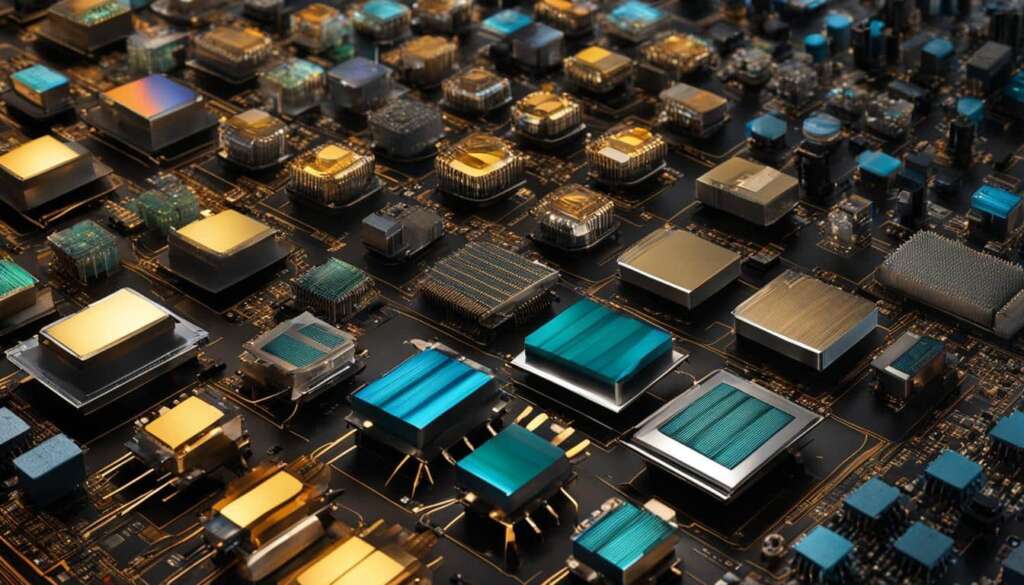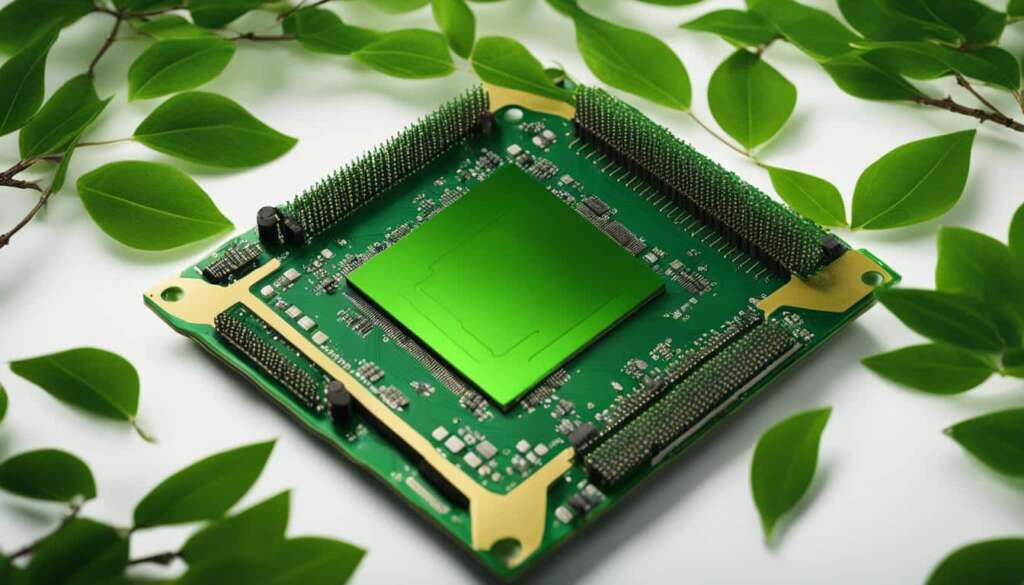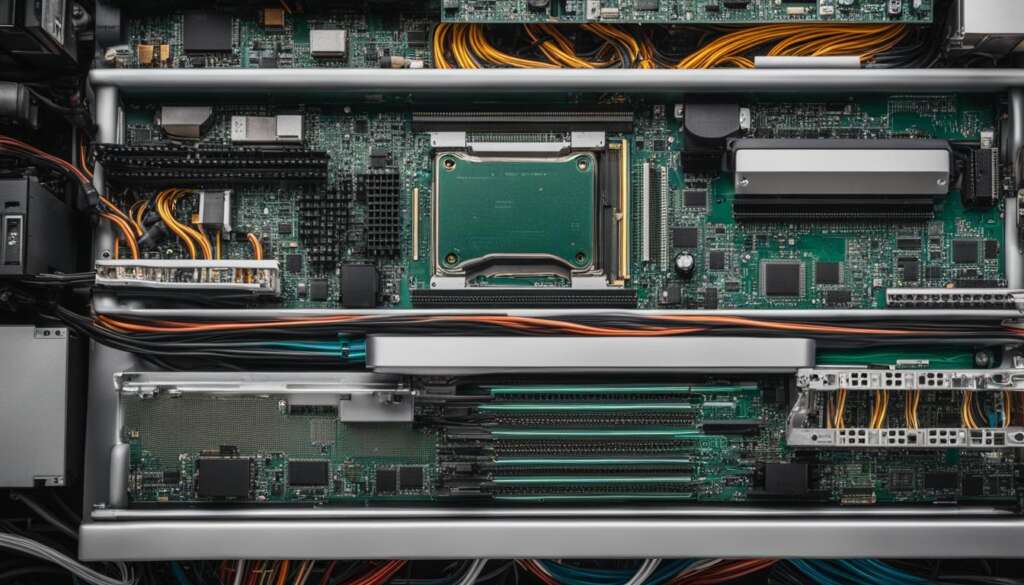Table of Contents
Smartphone processors have revolutionised mobile phone technology by providing increased computing power in a small space. ARM chips, known for their efficiency, efficiently feed instructions to microprocessors, allowing for high performance with minimal energy consumption. The introduction of 3G and 4G networks further enhanced the capabilities of smartphones by enabling data transmission at high speeds.
The Transformation from Basic Mobile Phones to Smartphones
In the early 1990s, mobile phones were primarily used for voice calls and text messages, while personal organizers provided business functionality. However, with the emergence of smartphones, these separate devices converged into a single versatile device. The affordability of mobile phones, along with the integration of features like cameras and music players, contributed to the widespread adoption of smartphones.
Smartphones revolutionized mobile technology by offering a wide range of functionalities that were previously limited to separate devices. The evolution from basic mobile phones to smartphones brought about a paradigm shift in the way we communicate, work, and access information.
With smartphones, users can now not only make calls and send texts but also browse the internet, check emails, take high-quality photos, access social media platforms, play games, and much more. The convergence of multiple functionalities in a single device has made smartphones an essential part of our daily lives.
The transformation of mobile phones into smartphones has revolutionized the way we live, work, and connect with others. It has brought about increased convenience, productivity, and entertainment, all in the palm of our hands.
The road from basic mobile phones to smartphones has been paved with technological advancements and consumer demand. The integration of mobile technology and the evolution of smartphones have shaped the way we interact with the world around us.
Key Features of Smartphones
| Feature | Description |
|---|---|
| Internet Connectivity | Smartphones allow users to access the internet, browse websites, and stay connected on the go. |
| Camera | Integrated cameras in smartphones have revolutionized mobile photography, allowing users to capture high-quality images and videos. |
| Applications | Smartphones offer a wide range of applications that enable users to perform various tasks, from productivity to entertainment. |
| Touchscreen | Touchscreens have replaced physical keyboards, providing a more intuitive and interactive user experience. |
| Long Battery Life | Advancements in battery technology have improved the battery life of smartphones, allowing users to stay connected for longer periods. |
As smartphones continue to evolve, we can expect further advancements in technology, such as 5G connectivity, augmented reality, and artificial intelligence. These advancements will shape the future of smartphones, making them even more powerful and indispensable in our lives.
The Technology behind Smartphones
Smartphones have become an integral part of our lives, offering a wide range of features and capabilities in a compact device. At the heart of these devices lies the technology that powers them: ARM microprocessors and 3G networks.
ARM microprocessors have played a crucial role in the evolution of smartphones. These low-power processors efficiently deliver computing power while consuming minimal energy, making them ideal for mobile devices. The development of ARM chips started with the ARM1 chip in 1985, and since then, they have continued to advance, providing increased performance and efficiency to smartphones.
The introduction of 3G networks further revolutionized smartphone technology. With the upgrade from 2G to 3G, smartphones gained the ability to access the internet at faster speeds, enabling multimedia capabilities, such as video streaming and internet browsing, on mobile devices. This advancement in connectivity opened up a whole new world of possibilities for smartphone users.
Advantages of ARM microprocessors and 3G networks in smartphones:
- Efficient performance: ARM microprocessors efficiently handle instructions, providing high performance with minimal energy consumption.
- Faster data transmission: 3G networks enable faster internet access, allowing users to browse the web, stream videos, and download files at higher speeds.
- Powerful computing: ARM microprocessors deliver the computing power needed for running complex applications and multitasking on smartphones.
- Enhanced multimedia capabilities: 3G networks enable users to enjoy multimedia content, such as streaming videos and music, on their smartphones.
Together, ARM microprocessors and 3G networks have paved the way for the advanced features and capabilities we see in modern smartphones. These technologies continue to evolve, with the development of more powerful processors and the introduction of 5G networks on the horizon, promising even greater possibilities for the future of smartphone technology.
| Advantages of ARM microprocessors | Advantages of 3G networks |
|---|---|
| Efficient performance | Faster data transmission |
| Powerful computing | Enhanced multimedia capabilities |
“The integration of ARM microprocessors and 3G networks has transformed smartphones into powerful devices that offer a wide range of features and capabilities. With efficient computing power and fast data transmission, smartphones have become essential tools in our daily lives.”
– Smartphone Technology Expert
Evolution of Smartphone Processors: From Single Core to Multi-Core
One of the key advancements in smartphone technology has been the evolution of mobile processors. In the early 2000s, smartphones predominantly featured single-core processors with 32 or 64-bit architecture. These processors provided sufficient computing power for basic tasks but were limited in their ability to handle more demanding applications.
However, as smartphones became more sophisticated and users demanded greater performance, the industry responded with the introduction of multi-core processors. Dual-core processors were the first to emerge, enabling smartphones to handle more complex tasks with improved efficiency. As technology continued to progress, quad-core and hexa-core processors were introduced, further boosting the processing power of smartphones and allowing for seamless multitasking and enhanced user experiences.
The transition from single-core to multi-core processors marked a significant milestone in the evolution of smartphone technology. By spreading the computational workload across multiple cores, smartphones are now capable of executing multiple tasks simultaneously, resulting in faster and more efficient performance. Whether it’s multitasking, gaming, or running resource-intensive applications, multi-core processors have revolutionized the way smartphones handle various tasks and provide a seamless user experience.
The Benefits of Multi-Core Processors in Smartphones
The introduction of multi-core processors in smartphones has brought forth several benefits:
- Enhanced Performance: Multi-core processors offer improved processing power, enabling smartphones to handle resource-intensive tasks, such as gaming and video editing, with ease.
- Efficient Multitasking: With multiple cores, smartphones can run multiple applications simultaneously without compromising performance, allowing users to switch between tasks seamlessly.
- Better Battery Life: Multi-core processors are designed to distribute workloads efficiently, allowing smartphones to achieve better power efficiency and optimize battery life.
- Future-Proofing: With advancements in software and app development, multi-core processors provide the necessary foundation for running future applications and technologies without compromising performance.
| Processor Type | Core Configuration | Advantages |
|---|---|---|
| Single-Core | 1 core | – Basic task handling – Limited performance |
| Dual-Core | 2 cores | – Improved multitasking – Enhanced performance |
| Quad-Core | 4 cores | – Seamless multitasking – Advanced gaming capabilities |
| Hexa-Core | 6 cores | – Smooth multitasking with demanding apps – Enhanced graphics processing |
As smartphone technology continues to advance, the focus remains on developing more powerful processors capable of handling increasingly complex tasks and providing an unparalleled user experience. From single-core to multi-core designs, the evolution of smartphone processors has been crucial in driving innovation and pushing the boundaries of what smartphones can achieve.
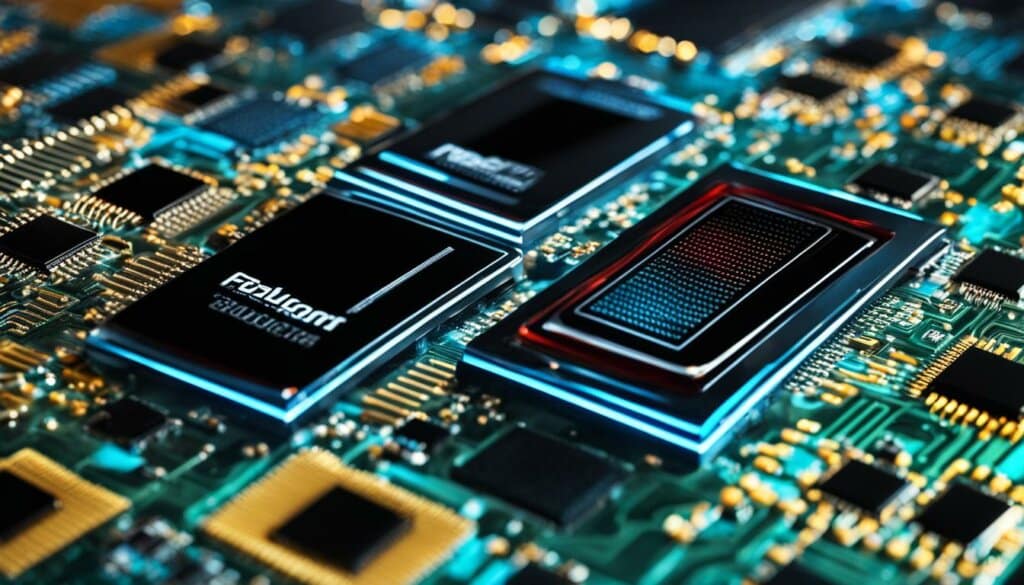
Top Mobile Processor Brands and their Innovations
When it comes to mobile processors, some brands have stood out for their innovations and contributions to smartphone technology. Let’s take a look at three leading mobile processor brands: Qualcomm Snapdragon, Apple A series, and MediaTek.
Qualcomm Snapdragon
Qualcomm Snapdragon processors have gained a reputation for their efficient performance and low heat generation. These processors incorporate advanced technologies to deliver high-performance computing while maintaining power efficiency. The Snapdragon series offers a wide range of processors tailored to different smartphone segments, from budget-friendly devices to flagship smartphones. Their processors are known for their superior graphics processing capabilities, making them ideal for gaming and multimedia experiences.
Apple A series
Apple’s A series processors are designed in-house and have become synonymous with high-quality visuals and processing capabilities. These processors are optimized to seamlessly integrate with iOS, providing a smooth and responsive user experience. Apple’s focus on vertical integration allows them to tightly integrate their hardware and software, resulting in impressive performance and power efficiency. The A series processors have played a significant role in enabling advanced features such as augmented reality (AR) and computational photography on iPhones.
MediaTek
MediaTek processors are known for offering a good balance between processing power and affordability. These processors cater to a wide range of smartphones, including mid-range and budget-friendly devices. MediaTek has been at the forefront of bringing advanced features to affordable smartphones, such as dual-camera capabilities and AI processing. Their processors are designed to provide smooth multitasking, efficient power consumption, and reliable connectivity. MediaTek continues to innovate, delivering processors that meet the demands of emerging markets and value-conscious consumers.
| Processor Brand | Innovations |
|---|---|
| Qualcomm Snapdragon | Efficient performance, superior graphics processing capabilities |
| Apple A series | High-quality visuals, optimized integration with iOS, advanced features |
| MediaTek | Good balance between processing power and affordability, innovative features |
These top mobile processor brands have played a crucial role in shaping the capabilities of smartphones. Through their continuous innovations, they have enabled the development of powerful, efficient, and feature-rich devices that cater to the diverse needs of smartphone users.
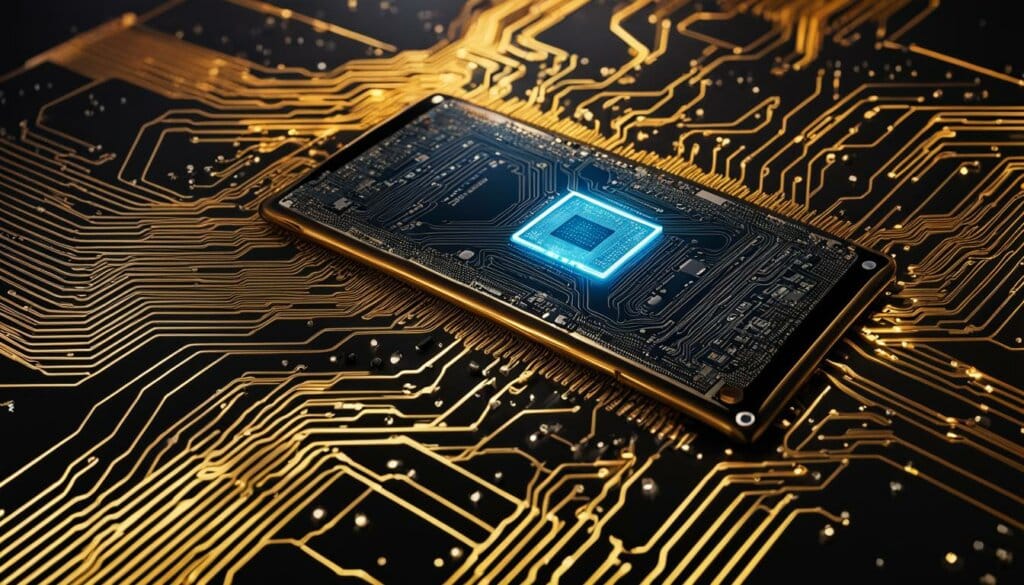
The Impact of AI on Smartphone Technology
Artificial intelligence (AI) has transformed the capabilities of smartphones, revolutionizing the way we interact with these devices. With AI integration, smartphones have become more intelligent, intuitive, and personalized to individual users. AI enables smartphones to analyze user behavior, predict their needs, and provide tailored suggestions, making daily tasks and activities more efficient and convenient.
One area where AI has significantly enhanced smartphone technology is in the field of photography. AI-powered camera systems in smartphones can recognize scenes, objects, and faces, automatically adjusting settings to capture the best possible photos. This technology has made high-quality photography accessible to everyone, enabling users to capture stunning images without the need for professional expertise.
“Artificial intelligence enables smartphones to analyze user behavior, predict their needs, and provide tailored suggestions” – Tech Expert
AI also plays a crucial role in improving battery life in smartphones. By analyzing usage patterns and optimizing power consumption, AI algorithms can help smartphones deliver longer battery life without compromising performance. This is particularly advantageous for users who rely heavily on their smartphones throughout the day and need extended battery endurance.
In addition to photography and battery optimization, AI has also bolstered cybersecurity measures on smartphones. With AI-powered security systems, smartphones can identify and block potential threats, such as malware and phishing attempts, ensuring the safety and privacy of user data and information.
The Future of Smartphone AI Technology
As AI technology continues to advance, the future of smartphone technology holds even more exciting possibilities. AI will further enhance smartphone cameras, enabling sophisticated image processing, augmented reality (AR) experiences, and advanced video recording capabilities. Additionally, AI-powered voice assistants, like Siri and Google Assistant, will become more intelligent and adept at understanding natural language, making interactions with smartphones more seamless and natural.
Furthermore, AI’s influence on smartphone technology will extend beyond individual devices. AI-enabled smartphones will be part of larger connected ecosystems, interacting with other smart devices and seamlessly integrating into smart homes or smart cities. This level of integration will enable users to control their surroundings and access information effortlessly, further enhancing the overall user experience.
| Advantages of AI in Smartphones | Examples |
|---|---|
| Enhanced photography capabilities | AI-powered scene recognition, intelligent camera settings |
| Improved battery life | AI-optimized power consumption |
| Enhanced cybersecurity | AI-powered threat detection and prevention |
| Seamless integration with connected ecosystems | AI-enabled smart homes and cities |
As AI technology continues to evolve and intertwine with smartphone technology, the possibilities for innovation and enhanced experiences are endless. From photography to battery optimization and beyond, AI is shaping the future of smartphones, making them more intelligent, efficient, and tailored to the needs of individual users.
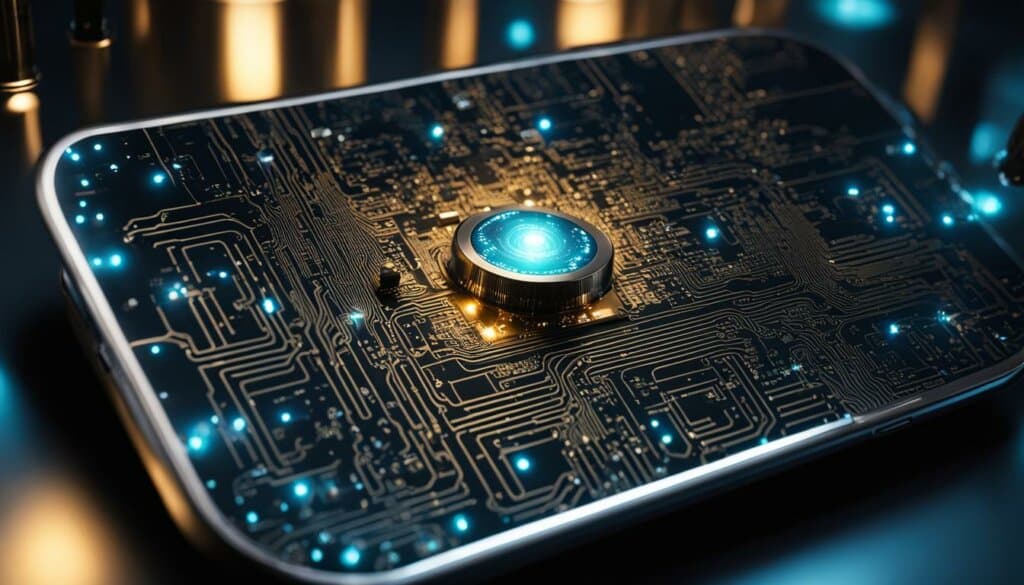
The Rise of Foldable Phones
Foldable phones are an innovative advancement in smartphone technology that is gaining traction in the market. These devices offer a unique and flexible form factor, providing users with the convenience of a compact smartphone that can transform into a larger-screen tablet-like device. Foldable technology allows for a seamless transition between different display sizes, offering users the best of both worlds in terms of portability and screen real estate.
One of the key advantages of foldable phones is their ability to provide a larger screen size in a compact form factor. When folded, these phones are similar in size to traditional smartphones, fitting comfortably in pockets or bags. However, when unfolded, they offer a significantly larger display, giving users more screen space for multimedia consumption, productivity tasks, and immersive gaming experiences.
Tablets, on the other hand, have always provided a larger display but are often less portable due to their size. The introduction of foldable phones bridges this gap by offering users a single device that combines the portability of a smartphone with the screen size of a tablet. This makes them an attractive option for users who value both mobility and the ability to have a larger display when needed.
| Foldable Phones | Advantages | Disadvantages |
|---|---|---|
| Convenient portability | Large screen size when unfolded | Higher price point |
| Seamless transition between form factors | Enhanced multitasking capabilities | Potential durability concerns |
| Improved user experience for multimedia consumption | Innovative and futuristic design | Less market availability compared to traditional smartphones |
The rise of foldable phones also opens up new possibilities for smartphone design and user experiences. Manufacturers have been experimenting with various folding mechanisms, such as the clamshell and book-style designs, to cater to different user preferences. As technology and manufacturing processes improve, foldable phones are expected to become more durable and affordable, making them a viable option for a broader range of consumers.
“Foldable phones represent a significant shift in smartphone design, offering users a more versatile and immersive experience. As the technology matures, we can expect foldable phones to become a mainstream choice for smartphone users.” – Smartphone industry expert
In conclusion, foldable phones are an exciting development in the smartphone industry, combining the portability of a smartphone with the screen size of a tablet. With continuous innovation and improvements in durability and affordability, foldable phones are poised to become a popular choice for users seeking a versatile and immersive mobile experience.
The Influence of 5G Technology on Smartphones
5G technology is set to revolutionize the smartphone industry, offering significant advancements in connectivity and performance. With faster speeds and wider coverage, 5G will enable users to experience seamless connectivity and unlock the full potential of their mobile devices.
One of the key benefits of 5G technology is its ability to handle massive amounts of data at incredibly high speeds. This means that users will be able to download large files, stream high-definition videos, and engage in real-time gaming without any lag or buffering. The improved network capabilities will also enhance the performance of applications that rely on cloud computing, such as augmented reality and virtual reality experiences.
Additionally, 5G technology will enable the Internet of Things (IoT) to flourish, connecting various smart devices and creating a truly interconnected digital ecosystem. From smart homes and smart cities to autonomous vehicles and wearable devices, the possibilities are endless. The low latency of 5G networks will ensure quick and efficient communication between devices, enabling seamless automation and remote control.
As smartphone companies gear up for the 5G revolution, a significant number of 5G-compatible phones are expected to hit the market in the coming years. These devices will not only offer faster connectivity but also be equipped with advanced features and capabilities to take full advantage of the new network technology. From enhanced AI capabilities to improved camera systems, 5G smartphones will redefine the way we interact with our mobile devices.
| Benefits of 5G Technology on Smartphones | Features of 5G-Compatible Smartphones |
|---|---|
|
|
The arrival of 5G technology heralds a new era of connectivity and innovation in the smartphone industry. With its faster speeds, wider coverage, and improved capabilities, 5G will unlock a multitude of possibilities and shape the future of mobile technology.
The Importance of Mobile Photography
Mobile photography has become a significant feature of smartphones, with users demanding higher-quality cameras and imaging capabilities. The introduction of 64-megapixel cameras in smartphones has further improved photo quality, allowing users to capture and share their experiences in stunning detail. The integration of high-resolution cameras aligns with the growing importance of social media in today’s digital world.
Smartphone manufacturers have recognized the increasing demand for exceptional mobile photography and have responded by equipping their devices with advanced camera technologies. From the ability to capture vibrant colors and sharp details to offering a variety of shooting modes and editing options, smartphones are now powerful tools for photography enthusiasts and casual users alike.
With high-resolution cameras, users can capture professional-level photos without the need for bulky DSLR cameras and extensive editing. The convenience of carrying a smartphone with a top-notch camera allows users to seize spontaneous moments and instantly share them with friends and family through social media platforms.
“The integration of high-resolution cameras in smartphones has revolutionized the way we capture and share our lives. With smartphones, everyone can be a photographer and instantly showcase their creativity to the world.”
In addition to capturing still images, smartphones have also made significant advancements in video recording capabilities. Many flagship smartphones now feature cinematic video stabilization, allowing users to capture smooth and professional-looking videos. High dynamic range (HDR) and slow-motion video recording are also becoming standard features, enabling users to explore their creativity and capture stunning moments in different ways.
The Evolution of Mobile Photography
The evolution of mobile photography has come a long way since the early days of blurry camera phones. The increasing demand for high-quality images has driven smartphone manufacturers to invest in research and development, resulting in exponential improvements in camera technology.
From the first smartphones with basic 2-megapixel cameras to today’s devices with multi-lens setups and advanced image processing algorithms, mobile photography has experienced a remarkable transformation. The integration of artificial intelligence (AI) has further enhanced camera capabilities, enabling features such as portrait mode, night mode, and scene recognition.
As smartphone cameras continue to improve, the boundaries between professional photography and mobile photography are blurring. Many professional photographers now rely on smartphones as secondary cameras or even as their primary tools for capturing stunning images.
| Smartphone Model | Camera Specifications | Sample Image |
|---|---|---|
| iPhone 12 Pro Max | Triple-lens system: 12MP Wide, 12MP Ultra Wide, and 12MP Telephoto | |
| Samsung Galaxy S21 Ultra | Quad-lens system: 108MP Wide, 12MP Ultra Wide, 10MP Periscope Telephoto, and 10MP Telephoto |
The Trend of Full-Screen Displays
Smartphone design has witnessed a significant shift with the rising popularity of full-screen displays. The seamless integration of edge-to-edge screens has transformed the way we interact with our devices, offering immersive visual experiences and maximizing screen real estate. The demand for larger displays without compromising the device’s overall size has led to the introduction of innovative design solutions.
Manufacturers have adopted various approaches to achieve full-screen displays, such as implementing water-drop notches and eliminating notches altogether. Water-drop notches, resembling a droplet falling on the screen, are smaller and less obtrusive than traditional notches, providing users with a larger usable display area. On the other hand, smartphones with no notches offer a truly bezel-less experience, utilizing advanced front-facing camera technologies like pop-up mechanisms or under-display cameras.
Ultimately, the goal of full-screen displays is to provide users with a captivating and immersive visual experience. Whether it’s watching movies, browsing social media feeds, or playing games, a larger screen-to-body ratio enhances the overall enjoyment. It also allows for more content to be displayed on the screen, making multitasking and productivity tasks more efficient.
“Full-screen displays offer a seamless and immersive visual experience, allowing users to dive into their favorite content like never before.” – Smartphone Design Expert
The future of smartphone design will continue to push the boundaries of full-screen displays. As technology advances, we can expect to see even more innovative solutions, such as under-display fingerprint sensors and front-facing cameras, as well as further minimizing bezels to create a truly edge-to-edge experience. The integration of these design elements will not only enhance the aesthetics of smartphones but also improve the overall user experience by providing larger, more immersive displays.
Advantages of Full-Screen Displays:
- Enhanced visual experience with immersive content consumption
- Maximized screen-to-body ratio for more content and efficient multitasking
- Improved aesthetics and sleek design
- Potential for innovative technologies like under-display sensors and cameras
Disadvantages of Full-Screen Displays:
- Greater vulnerability to accidental touches and screen damage without bezels
- Potential challenges in integrating front-facing camera and other sensors
- Higher manufacturing costs due to complex design and technologies
| Smartphone Model | Screen-to-Body Ratio | Notch Type |
|---|---|---|
| Phone A | 92% | Water-drop notch |
| Phone B | 95% | No-notch display |
| Phone C | 91% | Pop-up camera |
| Phone D | 93% | Under-display camera |
The Future of Smartphone Processors
As smartphone technology continues to advance at a rapid pace, the development of more powerful processors is crucial to meet the ever-increasing demands of users. Powerful processors are essential for delivering high-performance capabilities, enabling seamless multitasking, and supporting resource-intensive applications. To keep up with the evolving needs of smartphone users, processor advancements are driving innovation and shaping the future of mobile devices.
The future of smartphone processors lies in improved efficiency and enhanced performance. Manufacturers are investing in research and development to create processors that offer faster speeds, improved graphics rendering, and efficient power consumption. These advancements not only enhance the overall user experience but also enable the implementation of cutting-edge technologies such as artificial intelligence (AI) and augmented reality (AR).
Table: Comparison of Next-Generation Smartphone Processors
| Processor | CPU Cores | Architecture | AI Capabilities |
|---|---|---|---|
| Brand X | Octa-Core | 7nm | Advanced AI |
| Brand Y | Hexa-Core | 6nm | Smart AI |
| Brand Z | Deca-Core | 5nm | AI Supercomputer |
These advancements in smartphone processors will enable seamless multitasking, faster app launches, and improved battery life. Furthermore, the integration of AI capabilities within processors will enable smartphones to analyze data faster, provide real-time assistance, and deliver personalized user experiences. With AI becoming increasingly prevalent in various smartphone applications, powerful processors with enhanced AI capabilities are crucial for unlocking the full potential of this technology.
Conclusion
The evolution of smartphone processors has played a crucial role in shaping the capabilities of modern smartphones. As technology continues to advance, smartphones are becoming more powerful, versatile, and user-friendly. The integration of AI, 5G connectivity, and high-resolution cameras is fuelling future trends in smartphone technology, promising exciting developments and enhanced experiences for users.
Smartphone technology is constantly evolving, and we can expect to see even more innovation in the coming years. Powerful processors capable of supporting high-quality visuals and advanced functionalities will be in high demand. Additionally, advancements in processor technology, such as built-in 5G connectivity, will further enhance the capabilities of smartphones and meet the evolving needs of users.
Looking ahead, the future of smartphone technology holds great promise. With continuous advancements in AI, smartphones will become more intelligent and intuitive, understanding and predicting user needs like never before. The widespread adoption of 5G technology will bring about faster speeds, seamless connectivity, and enhanced performance. Furthermore, the integration of high-resolution cameras will continue to improve mobile photography, allowing users to capture and share their experiences in stunning detail.
In conclusion, the future of smartphone technology is bright. With ongoing advancements in processors and the integration of cutting-edge features, smartphones are set to become even more indispensable in our daily lives. From AI-driven personal assistants to lightning-fast 5G connectivity, the possibilities are endless. As we move forward, let’s embrace the exciting future trends in smartphone technology and the endless possibilities they hold.
FAQ
What is the role of smartphone processors in the evolution of smartphones?
Smartphone processors have revolutionized mobile phone technology by providing increased computing power in a small space. They efficiently feed instructions to microprocessors, allowing for high performance with minimal energy consumption.
How have smartphones transformed from basic mobile phones?
In the early 1990s, mobile phones were primarily used for voice calls and text messages, while personal organizers provided business functionality. With the emergence of smartphones, these separate devices converged into a single versatile device, offering features like cameras, music players, and more.
What is the technology behind smartphones?
ARM microprocessors, known for their efficiency, are instrumental in the advancement of smartphones. The upgrade from 2G to 3G networks further enhanced smartphone capabilities by enabling faster data transmission.
How have smartphone processors evolved over the years?
Initially, smartphone processors were single core with 32 or 64-bit architecture. Later, dual-core, quad-core, and hexa-core processors emerged. The integration of efficient and high-performance cores improved the overall processing power of smartphones.
What are some top mobile processor brands and their innovations?
Leading mobile processor brands include Qualcomm Snapdragon, Apple with their A series, and MediaTek. Snapdragon processors are known for their efficiency and low heat generation. Apple’s A series processors offer high-quality visuals and processing capabilities. MediaTek processors provide better processing and affordable pricing.
How has AI impacted smartphone technology?
AI technology in smartphones enables analysis of user behavior, personalized suggestions, improved photography features, battery life enhancement, and enhanced cybersecurity.
What is the future of foldable phones?
While foldable phone adoption is still limited, manufacturers are innovating in this area. Foldable phones offer larger screen sizes and new design possibilities, and as technology advances and costs decrease, foldable phones are expected to gain wider acceptance.
What is the influence of 5G technology on smartphones?
The advent of 5G technology revolutionizes the smartphone industry. With faster speeds and wider coverage, 5G enables seamless connectivity and enhances the performance of mobile devices. Smartphone companies are expected to release a significant number of 5G-compatible phones in 2020.
How important is mobile photography in smartphones?
Mobile photography has become a significant feature of smartphones. Users demand higher-quality cameras and imaging capabilities. The introduction of 64-megapixel cameras in smartphones has further improved photo quality, allowing users to capture and share their experiences in stunning detail.
What is the trend of full-screen displays in smartphones?
Full-screen displays offer immersive visual experiences. The introduction of water-drop notches and no-notch displays maximizes screen space, providing users with larger screen-to-body ratios. Full-screen designs continue to drive innovation in smartphone aesthetics.
What does the future hold for smartphone processors?
The development of more powerful mobile processors remains a focus in the smartphone industry. Processors capable of supporting high-quality visuals and advanced functionalities are in demand. Advancements in processor technology, such as built-in 5G connectivity, will further enhance the capabilities of smartphones and meet the evolving needs of users.
What are the key takeaways from the evolution of smartphone technology?
The evolution of smartphone processors has played a crucial role in shaping the capabilities of modern smartphones. As technology continues to advance, smartphones are becoming more powerful, versatile, and user-friendly. The integration of AI, 5G connectivity, and high-resolution cameras is driving future trends in smartphone technology, promising exciting developments and enhanced experiences for users.

